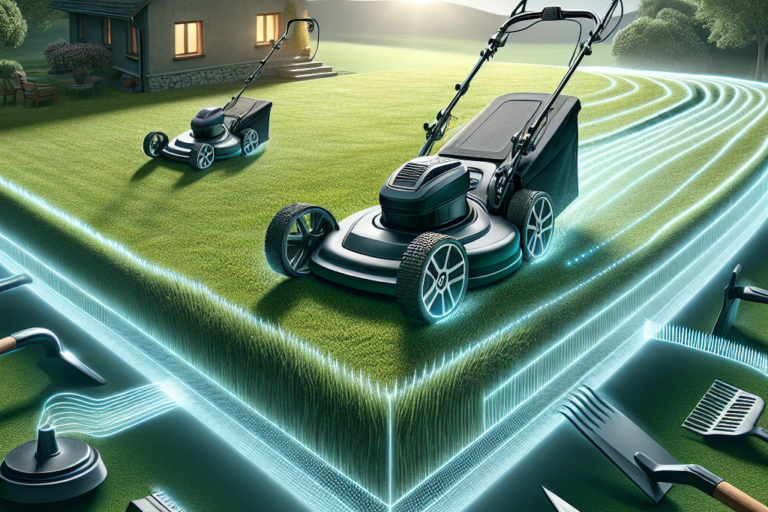Thinking about making the switch from a gas mower to an electric one? You’re not alone. With recent advancements in technology, many people are looking for more eco-friendly and cost-effective alternatives to traditional gas-powered machines. But the question remains, can you convert your gas mower into an electric one? In this article, we’ll explore the possibilities and considerations of converting your gas mower, giving you the information you need to make an informed decision. So, grab a cup of tea and let’s get started!

Choosing the Right Electric Motor
When considering converting your gas mower to an electric one, it is essential to choose the right electric motor. Understanding the power requirements of your mower is the first step in this process. Different mowers have varying power needs, so it is crucial to select an electric motor that can deliver sufficient power to meet your cutting needs.
Comparing different electric motors is also important to ensure that you choose the most suitable one for your mower. Look for motors that are known for their reliability and durability, as these qualities are critical for long-term performance. Additionally, consider factors such as motor size, RPM (Revolutions Per Minute), and torque to ensure a smooth and efficient operation.
Assessing the compatibility of the chosen electric motor with your mower is vital for a successful conversion. Consider aspects such as the motor’s physical dimensions and mounting requirements to determine if it will fit seamlessly into your mower’s existing design. Additionally, pay attention to the motor’s power requirements and check if they align with the electrical capabilities of your mower.
Evaluating the Mower’s Structure
Before embarking on the conversion process, it is crucial to evaluate the structure of your mower. This assessment involves examining the mower’s frame and drive system to ensure that they can support the electric conversion.
The mower’s frame should be sturdy and capable of handling the additional weight that comes with the electrical components. Check for any signs of damage or wear and make any necessary repairs or reinforcements before proceeding. Additionally, consider the drive system, including components like belts and pulleys, to ensure their compatibility with the electric motor’s power requirements.
Considering space for electric components is another crucial aspect. Evaluate the available space in your mower to ensure that there is ample room to accommodate the electric motor and other necessary components. If needed, you may have to make modifications to create space or relocate existing components.
Assessing the weight distribution is vital to maintain the mower’s balance and stability. Electric components can add significant weight, so ensure that the weight is distributed evenly throughout the mower to prevent any imbalance that could affect performance and maneuverability.
Selecting the Appropriate Battery
The battery is a vital component of an electric mower, and selecting the appropriate one is crucial for optimal performance. Determine the battery capacity you will require by considering factors such as the size of your lawn, the desired cutting time on a single charge, and any additional features or accessories that may draw power.
Evaluating battery voltage is necessary to ensure compatibility with the electric motor. The voltage should match or be within the acceptable range specified by the motor manufacturer. Selecting a battery with the correct voltage will ensure efficient operation and prevent damage to the motor or other components.
Consider the battery type and technology to find the best fit for your electric mower. Common choices include lead-acid batteries, lithium-ion batteries, and nickel-based batteries. Each type has its advantages and disadvantages, such as cost, lifespan, and weight, so weigh these factors against your specific needs and preferences.
Modifying the Mower’s Wiring
To convert your gas mower to an electric one, you will need to make modifications to the wiring system. This process involves removing the existing gasoline engine wiring and installing the necessary wiring for the electric motor.
Removing the gasoline engine wiring should be done carefully to avoid damaging other components or causing any electrical hazards. Take note of the existing wiring layout and disconnect it from the ignition system, fuel pump, and any other components specific to the gasoline engine.
Installing the electric motor wiring requires precision and attention to detail. Follow the manufacturer’s instructions and refer to wiring diagrams specific to your electric motor model. Ensure that all wires are properly connected, insulated, and secured to prevent any electrical malfunctions or accidents.
Adapting the controls and safety features is also crucial to ensure seamless operation and user safety. Modify or replace the controls previously used for the gasoline engine with electric motor-compatible controls. Additionally, ensure that all safety features, such as blade engagement sensors and emergency stop switches, are integrated into the new electrical system effectively.
Building the Electric Drive System
Building the electric drive system involves mounting the electric motor, connecting it to the blades or cutting mechanism, and ensuring proper belt tension or drive chain alignment.
Mounting the electric motor securely is essential to prevent vibrations or movement that could affect performance or damage other components. Refer to the manufacturer’s instructions for guidance on the appropriate mounting method, ensuring that it is both stable and aligned correctly with the mower structure.
Connecting the motor to the blades or cutting mechanism should be done with care. Ensure that the connection is strong and facilitates smooth rotation of the blades. Use appropriate tools and hardware, and check for proper alignment to avoid any unnecessary strain or damage to the motor or cutting mechanism.
Ensuring proper belt tension or drive chain alignment is crucial for optimal power transfer and efficient operation. Follow the manufacturer’s recommendations for the specific electric motor and mower model to adjust the tension or alignment accordingly. Proper tension or alignment will prevent slipping, excessive wear, and potential damage to both the motor and the cutting mechanism.
Integrating the Battery System
Integrating the battery system involves determining the battery placement, creating a secure enclosure, and wiring the battery to the electric motor.
Determining the battery placement should consider factors such as weight distribution, available space, and accessibility for maintenance and charging. Choose a location that ensures proper balance and stability while allowing easy access for battery removal and installation. Additionally, consider any ventilation or cooling requirements for the battery to prevent overheating.
Creating a secure enclosure for the battery is essential to protect it from external elements and potential damage. Design or modify an enclosure that provides adequate protection against moisture, debris, and impacts. Ensure that the enclosure is well-vented and allows for proper heat dissipation to prevent any safety hazards.
Wiring the battery to the electric motor requires precision and adherence to safety guidelines. Use appropriate wiring connectors, fuse protection, and insulation to ensure secure and uninterrupted power supply. Follow the wiring diagram provided by the electric motor manufacturer, and double-check all connections to avoid any electrical faults or hazards.

Addressing Charging and Power Management
As an electric mower owner, it is important to consider charging and power management options for your battery system.
Choosing a charging method depends on your available resources and preferences. Options include using a standard electric power outlet, a dedicated charging station, or even solar charging systems. Consider factors such as charging time, convenience, and long-term costs to make an informed decision.
Implementing a battery management system can optimize charging and prolong battery life. These systems monitor and control the charging process to prevent overcharging or undercharging, balance cell voltages, and protect against excessive discharge. Consult with an expert or refer to the battery and charger manufacturer’s recommendations for appropriate management system options.
Considering solar charging options can be a sustainable and environmentally friendly choice. Solar panels can harness the power of the sun to charge your electric mower’s battery, reducing reliance on traditional power sources. Evaluate the feasibility of incorporating solar panels into your setup, taking into account factors such as available sunlight, panel size, and budget.
Testing and Fine-Tuning the Conversion
Once the conversion is complete, it is essential to thoroughly test and fine-tune the mower to ensure optimal performance and safety.
Conducting electrical risk assessments is necessary to identify and address any potential electrical hazards. Inspect the wiring, connections, and components for any signs of wear, damage, or loose ends. Use appropriate testing tools and equipment to check for proper electrical continuity and insulation, ensuring that all safety measures are in place.
Checking motor rotation and blade engagement is vital to confirm that the motor is functioning correctly and that the blades or cutting mechanism are engaging properly. Start the mower and observe the rotation direction of the motor. If the rotation is incorrect, refer to the motor’s documentation to reverse it. Additionally, test the blade engagement mechanism to ensure smooth operation and a secure connection.
Adjusting speed and power settings may be necessary to achieve your desired cutting performance. Some electric motors or controllers allow for speed and power adjustments. Refer to the manufacturer’s instructions to make any necessary adjustments, balancing the desired cutting ability with battery life and motor longevity.
Maintenance and Safety Considerations
To keep your electric mower running smoothly and ensure safe operation, it is important to perform routine inspections, maintain battery health, and follow proper safety practices.
Performing routine inspections involves regularly checking the condition of the wiring, connections, and components. Look for signs of wear, corrosion, or loose connections, and address any issues promptly. Keep the mower clean and free from debris to prevent potential damage or obstructions.
Maintaining battery health is crucial for optimal performance and longevity. Follow the manufacturer’s recommendations for battery maintenance, including regular charging and proper storage. Avoid overcharging or deep discharging the battery, as this can negatively impact its lifespan and performance. Additionally, periodically inspect the battery for any physical damage or signs of deterioration.
Ensuring safe operation is of utmost importance to protect yourself and others. Always follow safety guidelines and instructions provided by the mower and electric motor manufacturers. This includes wearing appropriate protective gear, using safety features such as blade guards, and observing precautions when charging or working near the electrical components.
Understanding Legal and Warranty Implications
When converting your gas mower to an electric one, it is essential to understand the legal and warranty implications that may arise.
Reviewing manufacturer warranties is crucial to ensure that the conversion does not void any existing warranties. Some manufacturers may allow electric conversions without voiding warranties, while others may have specific guidelines or restrictions. Familiarize yourself with the terms and conditions of your mower’s warranty before proceeding with the conversion.
Evaluating local regulations and emission standards is important to ensure compliance with applicable laws. Some regions may have specific regulations regarding emissions, noise levels, or safety standards for mowers. Research and understand these requirements to ensure your electric mower meets all necessary legal standards.
Considering potential insurance issues is also important, especially if you have an existing insurance policy that covers your gas mower. Contact your insurance provider to inquire about coverage for electric mower conversions. They may provide recommendations or require specific documentation to update your policy accordingly.
Converting your gas mower to an electric one can be an exciting and eco-friendly project. By understanding the power requirements, evaluating the mower’s structure, selecting the appropriate battery, modifying the wiring, building the electric drive system, integrating the battery system, addressing charging and power management, testing and fine-tuning the conversion, and considering maintenance, safety, and the legal implications, you can enjoy the benefits of an electric mower while prolonging the life of your equipment and reducing your environmental impact.






